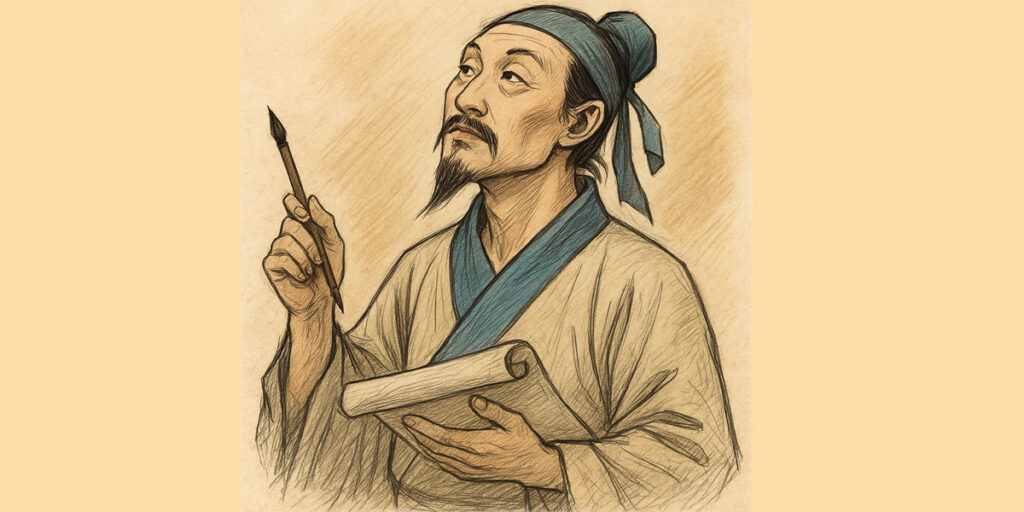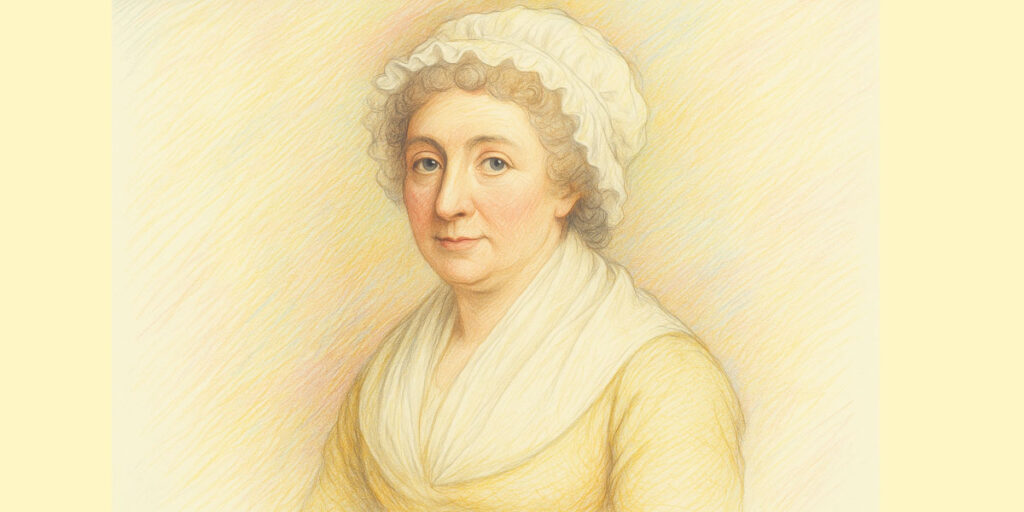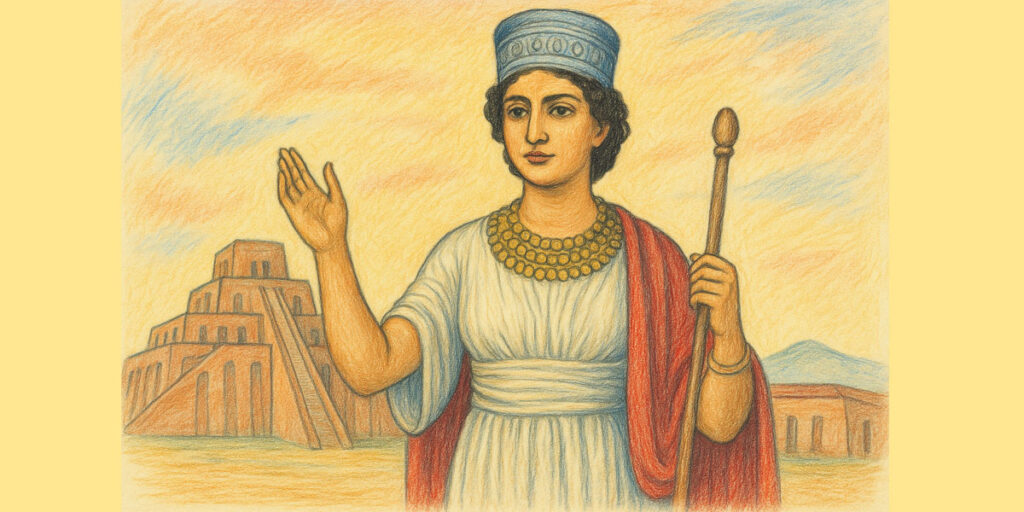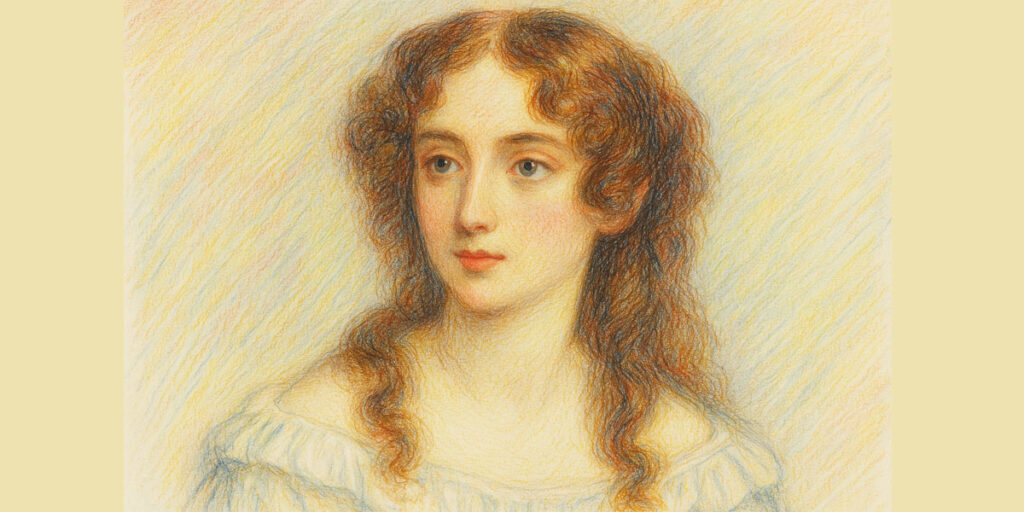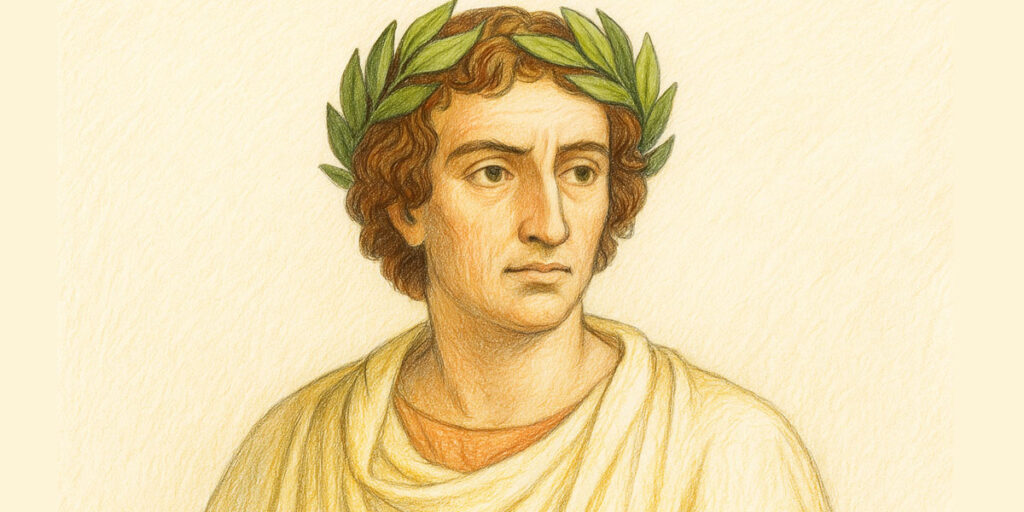Prologue: Dawn on Lesbos
Imagine a rosy dawn breaking over the cerulean waves of the Aegean Sea. On the island of Lesbos, around 630 BCE, a young woman named Sappho slips from her chamber, lyre in hand, ready to weave magic into the morning air. Her voice, clear and intimate, will ripple across centuries—even if only fragments of her songs survive today.
The Lyric Muse
Sappho wasn’t writing grand epics of gods and heroes—she wrote of longing, of whispered secrets between friends, and of the fierce, tender ache of desire. Her verses are snapshots of intimacy: the trembling heart at a lover’s glance, the ache of separation, the bliss of reunion. In her hands, everyday moments—picking flowers, walking by moonlight—become luminous, charged with emotion.
Fragments of a Shattered Mirror
Today, we possess only about one hundred complete lines of Sappho’s poetry. The rest exists as tantalizing fragments on scraps of papyrus and tattered manuscripts. Yet each broken piece feels like a shard of stained glass—jewel-bright, hinting at a larger, radiant whole. Scholars and artists alike have spent centuries piecing these shards together, trying to hear her full song.
A Language All Her Own
Sappho’s Greek was soft and musical, rich in metaphors drawn from nature: “love is the swiftest of horses,” she writes, or likens passion to “a sweet breeze that steals over the sea.” Her wordplay and intricate rhythms were groundbreaking—she stretched the possibilities of lyric form, crafting verses that shimmer with emotion and nuance.
Sisters of the Lyre
In Sappho’s world, poetry was a communal act. She led a circle of young women—perhaps a kind of proto-academy—where songs and dances intertwined. Through these gatherings, she forged bonds of sisterhood and creative collaboration. Though details remain murky, the idea of women learning, performing, and inspiring each other still feels radical today.
Love Beyond Labels
Modern readers have long been captivated by Sappho’s frank celebration of female desire. Her poems address “the incomparable one” with unabashed admiration and passion. While ancient society had its own conventions, her verses speak to us across millennia as a testament to love’s universal force—beyond gender, beyond time.
The Mystery of Her Life
Who was Sappho, beyond her poems? Ancient biographers tell tantalizing tales—of a banishment for political intrigue, of marriage and children, of a tragic leap from a cliff (the legendary “Leucadian Leap”). Yet truths blur with myth. Perhaps it’s fitting: Sappho herself embraced the elusive, the ineffable quality of emotion.
Echoes in Modern Verse
From Virginia Woolf to Audre Lorde, from Ezra Pound’s translations to contemporary spoken-word artists, Sappho’s spirit echoes in every poem that dares to explore the inner landscape of the heart. Her fragments have inspired countless reconstructions, multimedia installations, and innovative translations—proof that her voice still sings in our collective imagination.
Epilogue: A Candle in the Ruins
Today, when you read even a few lines of Sappho, you hold in your hands a flicker of bronze-aged flame—warm, alive, and fiercely human. Though the halls of her home have long fallen to ruin, her lyric spark endures, inviting each of us to listen to the music of desire, friendship, and the wondrous complexity of the soul.
The Island as Inspiration
Lesbos itself is a character in Sappho’s poetry—a landscape of olive groves, wildflowers, and craggy cliffs. She paints the island in hues of rosemary-scented breezes and sun-warmed stones, making the terrain as intimate as a lover’s embrace. Every sea-spray and rustling leaf becomes a metaphor for the heart’s own shifting tides.
The Power of Silence
Between Sappho’s surviving lines lie pregnant silences—pauses that feel as meaningful as words. These gaps invite us to imagine what’s unsaid: the tremor before a confession, the hush at a final farewell. In those spaces, our own stories take root, bridging the millennia between then and now.
Ritual and Celebration
Sappho’s poems often pulse with the rhythms of festival life—choral songs for weddings, hymns to Artemis, dances under lantern-lit skies. Through her verses, we glimpse ceremonies where poetry and ritual intertwine, where every lyric is an act of communal magic.
The Art of Translation
To read Sappho is to wrestle with translation’s art. Every version—whether literal, adaptive, or avant-garde—reveals a different facet of her lyric glow. Translators become creative partners, each line reborn in a new voice, reminding us that poetry is a living thing.
Fragmentary Alchemy
What can become of a few burned papyrus scraps? Through scholarly devotion and digital reconstruction, those fragments have been alchemized into entire performances—stage readings, musical compositions, even VR experiences. Sappho’s poetry thrives across mediums, proving that art transcends its vessel.
Love’s Many Faces
In her verses, Sappho portrays not only romantic love but friendships brimming with affection, maternal tenderness, and the exhilaration of youthful camaraderie. Her poems remind us that love wears many masks—each one beautiful, each one deserving of its own lyric.
Sappho and Modern Music
From choral adaptations in contemporary classical concerts to indie musicians sampling her lines in alt-pop hits, Sappho’s words resonate in our playlists. Her theme of burning desire finds new expression in electric guitars and synthesizers, proving her universality.
The Gender Question
While ancient labels differ from our own, Sappho’s emphasis on female desire challenges us to expand our definitions of identity. Her work has become a cornerstone for LGBTQ+ communities, offering a historical testament to love’s fluidity and defiance of rigid categories.
Digital Resurrection
Today, apps and websites let us explore Sappho’s fragments with interactive maps, audio recitations, and annotated commentaries. Technology has breathed fresh life into her work, making her voice accessible to anyone with a smartphone—just as she would have wanted, sharing songs under open skies.
Sappho’s Enduring Mystery
After nearly 2,600 years, Sappho still surrounds us with questions: How did she teach her circle? What tunes accompanied her songs? Where exactly did she write her greatest verses? These mysteries keep her alive in our collective curiosity—ensuring that each new discovery, no matter how small, feels like unearthing a buried treasure.
The Lyric Body
Sappho’s poetry celebrates the body—its trembling pulse, the softness of skin, the flutter of eyelashes. Her words map the intimate geography of human flesh, reminding us that poetry can be as tactile as velvet beneath the fingertips.
Nature’s Mirror
Beyond sea and sky, Sappho sees her own emotions reflected in the world around her: the moon’s pale glow echoes a lover’s cool kiss, the spring bloom mirrors the heart’s awakening. Her verses teach us to read feeling in every petal and cloud.
The Educator’s Voice
More than a solitary genius, Sappho was a mentor. Her “poetic school” likely taught meter and melody, guiding young poets in crafting their own songs. In this light, she emerges not just as an artist but as a pioneer of creative education.
Music in Meter
Ancient Greek lyric was meant to be sung. Modern reconstructions pair Sappho’s fragments with reconstructed melodies based on archaeological findings. Hearing her words set to music offers a sensory bridge across time, as if we stand beside her lyre.
Sacred and Secular
Sappho’s corpus spans the sacred—hymns to gods like Aphrodite—and the secular—playful ditties about daily life. This duality reveals a poet comfortable in temple courtyards and village festivals alike, weaving the divine into the mundane.
The Feminine Divine
Through ritual verses to goddesses, Sappho channels female divinity. Her hymns to Artemis and Aphrodite position women at the heart of the sacred, suggesting a spiritual landscape shaped by feminine power and grace.
Resilience Through Ruin
Ellis Island’s fragments, Egyptian papyri, medieval codices—Sappho’s work survives against staggering odds. Each recovered piece is a testament to resilience: poetry that endures political upheaval, library fires, and neglect, still speaking to us.
The Politics of Poetry
Lesbos in Sappho’s time was a hub of aristocratic intrigue. Some scholars argue her circle engaged in political and cultural debates, using poetry as subtle commentary. In this view, her work dances on the edge of social transformation.
Iconic Imagery
From the “rosy-fingered dawn” of Homeric epics to Sappho’s own luminous metaphors, Greek poetry brims with color. Yet Sappho’s imagery—lilies trembling in evening wind, the tremor of a hidden sigh—feels uniquely vivid, as though painted in pastel strokes.
A Global Sisterhood
Today, women’s poetry festivals, online forums, and book clubs around the world invoke Sappho’s spirit. Her legacy has become a rallying point for voices across continents, creating a modern sisterhood that spans cultures and languages.
The Poetic Architect
Sappho’s careful construction of stanzas—known now as “Sapphic stanzas”—reveals her as an architect of form. Each line balances rhythm and melody, building a structure that supports the emotional weight of her words, like a pavilion of sound under Aegean skies.
Coded Longing
In a society with strict decorum, Sappho mastered the art of suggestion. Through veiled imagery and innuendo—“that fire in your eyes” or “softest whisper of petals”—she cloaks desire in poetic mist, inviting readers into an intimate dance of interpretation.
Muse of Modern Artists
From Salvador Dalí’s surreal canvases to contemporary street-art murals, Sappho’s fragments ignite visual creativity. Artists transpose her lines onto walls, canvases, and installations, letting her ancient whispers color modern spaces.
Cinematic Echoes
Screenwriters and filmmakers seep Sappho’s themes into scripts—star-crossed love, the ache of exile, vibrant female friendships. Though rarely credited explicitly, her emotional blueprint underlies countless cinematic love scenes and coming-of-age tales.
Feminist Vanguard
Before “feminism” existed, Sappho’s poetry centered women’s experiences and voices. By chronicling women’s joys and sorrows as worthy of art, she paved the way for centuries of women writers to follow, a quiet revolution born in lyric.
The Archaeologist’s Prize
Every new papyrus fragment bearing Sappho’s hand sends ripples through academia. Egyptian sands and Oxyrhynchus tombs have yielded precious scraps, each discovery expanding our portrait of her genius and underscoring the thrill of literary archaeology.
Island Networks
Lesbos wasn’t an insular backwater but part of vibrant maritime networks. Sappho’s circle likely hosted travelers—merchants, poets, pilgrims—exchanging ideas and songs. In her world, poetry was as mobile as the ships that plied the Aegean.
Dialect’s Delight
Sappho wrote in the Aeolic dialect, infusing her work with regional flavor—slightly different spellings, unique vowel sounds, localized idioms. That dialectal melody contributes to her voice’s distinctiveness and challenges translators to capture its music.
Echoes in the Renaissance
Though largely lost to medieval Europe, Sappho’s reputation resurfaced during the Renaissance. Humanists scoured Byzantine manuscripts for her name; her legend inspired sonnets and madrigals, reawakening interest in female poetic expression.
The Performance Space
Sappho’s poetry wasn’t meant for private reading—she performed in courtyards and festival grounds. Imagining her voice echoing off stone walls, we sense the electric connection between poet and audience, a live-wire exchange charging every syllable with immediacy.
The Private Verses
Among her fragments are deeply personal lines—poems of heartbreak, jealousy, friendship turned sour. These “private verses” pull back the curtain on ancient emotions, reminding us that even legendary artists wrestle with daily heartache.
Cross-Cultural Ripples
Long before modern globalization, Sappho’s themes of love and longing resonated beyond Greece. Poets in Anatolia and Sicily adapted her style, weaving Aeolic echoes into their own tongues, forging a cultural tapestry as vast as the Mediterranean.
The Lyre’s Craftsmanship
An often-overlooked companion to her words is the lyre itself—its design, string tension, and tuning. Recreated by historians, these instruments let us pluck and strum through history, hearing the literal harmonies that shaped each fragment.
Epistolary Inspirations
Some scholars detect in Sappho’s tone the intimacy of a letter—direct addresses and personal asides that feel conversational rather than formal. This epistolary quality prefigures the personal essay and modern confessional poetry.
Theatrical Adaptations
From ancient Greek dramas inspired by her life to contemporary one-woman shows, Sappho’s story has been staged countless times. Each production reinterprets her myth, blending music, movement, and monologue into a living tribute.
Botanical Symbolism
Flowers and plants abound in her imagery—not just decor, but symbols of love’s stages. The rose for passion, the violet for modesty, the myrtle for marriage—Sappho’s botanical lexicon invites us to see gardens as secret codes of emotion.
Celestial Metaphors
Stars, moonlight, and the arc of the sun become stand-ins for desire’s trajectory. In Sappho’s sky, constellations chart the course of love’s journey, and lunar phases mirror the waxing and waning of longing.
The Silence of Time
Despite millennia of study, Sappho remains partly veiled, her life as fragmentary as her poems. This silence compels us to listen more closely, to cherish each line as a rare echo of human vulnerability preserved against oblivion.
The Evergreen Influence
In classrooms worldwide, Sappho’s name sparks debates on authorship, gender, and translation. Her fragments enrich syllabi from Ancient Greek to Women’s Studies to Creative Writing, ensuring that her lyric spark lights new minds every generation.
- c. 630 BCE – Birth on Lesbos
Sappho is born into an aristocratic family in Eresos. Her early years among olive groves and seaside cliffs sow the seeds of her poetic vision. - c. 610 BCE – First Lyric Musings
As a teenager, Sappho begins crafting short choral songs for local festivals, experimenting with Aeolic meter and setting everyday emotions to music. - c. 600 BCE – Hymn to Aphrodite
Composed at the peak of her powers, this prayer-like poem invokes the goddess of love to heal a broken heart. It stands as her most celebrated complete work, celebrated for its direct plea and elegant rhetoric. - c. 595 BCE – Wedding Songs
Sappho writes a series of epithalamia—songs of celebration and counsel performed at bridal processions. These pieces balance joyous imagery (myrtle garlands, rosy wine) with tender advice for newlyweds. - c. 590 BCE – “Ode to Anaktoria”
Dedicated to a beloved friend, this fragment captures Sappho’s mastery of longing and memory. Though surviving only in a handful of lines, it shaped later notions of erotic lyric. - c. 580 BCE – Choral Dithyrambs and School Leadership
Sappho’s circle reaches its full flowering: she composes larger-scale choral pieces and mentors young musicians. Her school on Lesbos becomes famed for blending dance, song, and poetic instruction. - c. 575 BCE – Devotional Hymns
Expanding beyond Aphrodite, Sappho pens hymns to Artemis and other deities, weaving personal devotion into communal ritual. These works highlight her dual command of secular and sacred verse. - c. 570 BCE – Final Fragments
In her later years, Sappho’s shorter, more intimate “private verses” emerge—brief, introspective snapshots of love’s complexities. These fragments, preserved on papyrus, would centuries later rekindle her lyric spark. - Posthumous Echoes (3rd century BCE onward)
Though Sappho’s own library fades, Hellenistic scholars quote her lines in anthologies. By the Roman era, her name is synonymous with female lyric, ensuring that even shattered fragments continue to resonate through time.
c. 200 CE – Quoted by Athenaeus
The Greek gourmand Athenaeus cites several Sappho fragments in his Deipnosophistae, preserving lines that would otherwise have vanished and attesting to her popularity in antiquity.
- 6th Century CE – Byzantine Anthologies
Sappho’s name and a handful of verses appear in Byzantine florilegia (excerpt collections), ensuring her work survives the turmoil of the early medieval period. - 10th–11th Centuries – Manuscript Transmission
Monastic scribes copy Sappho’s fragments into codices alongside other lyric poets, embedding her lines within larger anthologies of Greek poetry. - 1508 – First Printed Greek Edition
Venetian humanist Aldus Manutius includes Sappho’s surviving fragments in his pioneering Thesaurus Graecae Linguae, bringing her work into the Renaissance print era. - 1652 – First Latin Translation
Sappho makes her debut in the vernacular: French scholar Jean Chapelain’s Latin renderings introduce European readers to her lyric voice beyond the original Greek. - 1781 – Critical Edition by Johann Schweighäuser
German philologist Schweighäuser publishes a scholarly edition of Sappho’s fragments with extensive commentary, laying foundations for modern textual criticism. - 1896 – Discovery of Oxyrhynchus Papyri
Archaeologists unearth dozens of new Sappho fragments at Oxyrhynchus, Egypt, dramatically expanding the corpus and reshaping understandings of her oeuvre. - 1927 – Lobel & Page Critical Text
Edgar Lobel and Denys Page release their authoritative edition Poetae Lyrici Graeci, standardizing Sappho’s text and fragment numbering for generations of scholars. - 1958 – Mary Barnard’s English Translation
Poet-translator Mary Barnard publishes a celebrated English version, combining fidelity and lyric grace, which helps spark mid-20th-century feminist interest in Sappho. - 1997 – Anne Carson’s If Not, Winter
Innovative poet-scholar Anne Carson issues a hybrid translation/commentary that juxtaposes Greek fragments with her own creative interpolations, winning both popular and academic acclaim.

